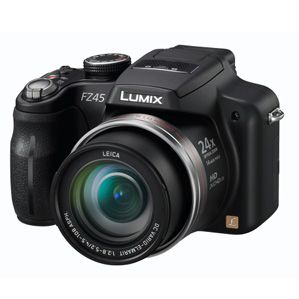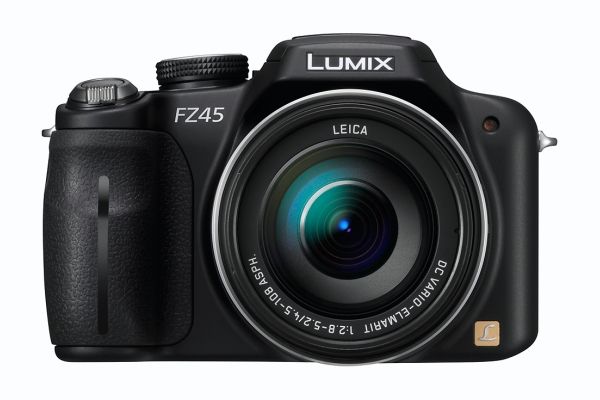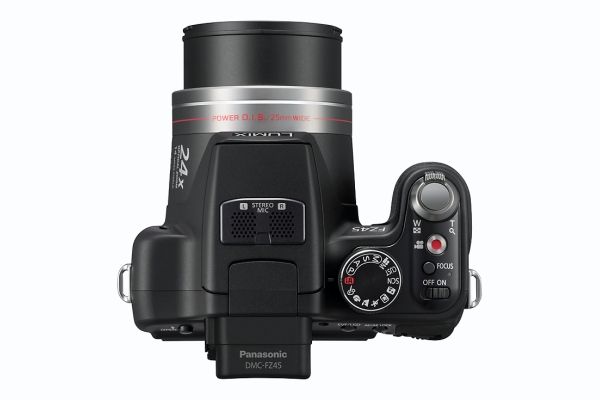Announced at the same time as the previously reviewed Panasonic Lumix DMC-FZ100, the more affordable FZ45 employs the same digital SLR-like styling, 14.1-megapixel effective resolution, and fields an optically stabilised 24x zoom lens, offering a wide-angle 25-600mm equivalent in 35mm film terms. In many respects then these two “mega zooms” are peas from the same pod, further including stereo sound recording and 1280 x 720 HD movies in AVCHD Lite or Motion JPEG format with dedicated red record button.
Our quick take
We see the FZ45 as best suited to families wanting an affordable all-in-one option for general photography. In terms of where it sits in the Panasonic Lumix range, the DMC-FZ45 comes across as a pared down version of the FZ100, omitting that camera’s tilting higher resolution LCD and more sophisticated features such as a hotshoe for accessory flash and Full HD video. What the FZ45 does have in its favour however, is that it suggests better value, whilst retaining most of its bigger brother’s operational bells and whistles aside from the ones mentioned.
Ultimately this is a camera that almost anyone should be able to quickly get to grips with, indicating appeal to the widest possible audience. It’s also one that can cope with most potential photographic subjects at a variety of focal lengths in a second or two. Whilst not perfect, we feel that at its current street price it’s a bit of a steal.

Panasonic Lumix DMC-FZ45 - 3.5 / 5
| FOR | AGAINST |
|---|---|
|
|
The latter is very useful in that it allows the recording of video clips to begin no matter what alternative mode might be selected on the familiar top plate shooting mode dial. Left and right microphones are located above the FZ45’s lens and set within the mechanism for the pop-up flash to keep proportions as compact as can be; but be warned that there’s no top-mounted hotshoe as on the FZ100 for adding accessory flash. A serious matt black finish helps disguise the fact that the camera might otherwise appear a little plastic-y.
What we also miss here is the compositional advantage of the FZ100’s high-resolution “free angle” tilt and swivel LCD. The FZ45’s 3-inch, standard 230k-dot resolution back screen is resolutely fixed; one reason why this camera hits a slightly lower price point. There’s the alternative of an electronic viewfinder (EVF) located directly above for shot composition and review, with a dedicated button allowing for the swapping between this and the LCD in an instant. That said we rarely felt the need to deviate from the larger screen, seeing as it was perfectly viewable under most lighting conditions and the EVF feels pokey by comparison.
Being in many respects a DSLR “lite”, those looking for portability should note that the FZ45, which actually succeeds the FZ38, is too chunky to fit in any pocket. With dimensions measuring 120.3 x 79.8 x 91.9mm, it weighs a reassuringly sturdy 498g - almost as heavy as a body-only entry-level DSLR. Its comfortably finger-moulded handgrip helps maintain a steadiness when shooting handheld, your left hand instinctively cupping the metal lens surround, into which the lens retracts when not in use.
Of course we have to set the FZ45 in context, and Panasonic isn’t the only manufacturer fielding large lens-ed models, former leading exponents in the 30x Fujifilm FinePix HS10 (a more robust, less plastic-y build in our opinion), and Olympus SP-800UZ recently superseded by the 35x Canon PowerShot SX30 IS, so competition is hotting up. So does the FZ45 feel slightly underpowered in comparison, or does it, in truth, offer all the zoom power you might ever need?
Let’s not forget that the Panasonic’s lens reach offers the versatility of shooting extreme wideangle landscapes or candid spur-of-the-moment close ups, along with everything in between. In that respect it’s a very convenient jack-of-all-trades option, and with street prices around £250 at the time of writing feeling more realistic than its manufacturer’s suggested £379.99, the FZ45 doesn’t actually cost much more than the average 5x zoom snapshot in real terms. Bargain!
A slide of the top mounted on/off switch and the FZ45 prepares itself for action in just over 2 seconds - average for its class - rear LCD blinking into life and lens adjusting to maximum wide angle setting with an audible mechanical whirr in anticipation of the next shot. The longer lens and the ability to shoot up to 10 frames per second suggests the camera as a possible accomplice for action shooting, as does AF tracking which attempts to lock onto target, keeping your subject sharply focused as they move through the frame. Swiftness often comes with a caveat however, and in this case it’s that resolution drops to 3 megapixels at top shooting speed, so images will appear softer than they already do on occasion when shooting at maximum zoom.
Typically, even shooting relatively static subjects, we needed two or three attempts to get our subject sharp when shooting handheld at longer focal lengths. That this is possible is in itself commendable however. A jog dial further enhances ease of use, whilst Panasonic’s My Colour Mode and Film Mode effects made it easy to customise the appearance of our images in camera - the latter being one area in which Panasonic differentiates itself from the competition, apart that is for Fujifilm with its own Astia, Velvia and Provia ape-ing film modes.
A large, obvious rocker switch for controlling the optical zoom encircles the shutter release button, enabling immediate access. Give this a nudge and the lens takes around three seconds to motor through its “basic” 24x optical range, or 4 seconds total to paddle on up to a 32x equivalent if you keep your finger on it, the trade off again being a deterioration in sharpness. Thankfully we could access the full extent of the zoom whether we were shooting video or stills, even though it’s not whisper quiet in operation during movie mode and much slower to move through its range.
In terms of picture quality, for those who want to do as little post processing with their images as possible the FZ45 doesn’t disappoint, though basic adjustments for brightness and contrast can add a welcome bit of depth. Otherwise colours are typically warm and well saturated on its default settings. Obviously you get what you pay for though, and the overall quality delivered by a £250 camera isn’t a match for one costing £600. A case in point: we came to the FZ45 after we had been playing the same manufacturer’s interchangeable lens Lumix DMC-GF2 however, and the difference in quality - in terms of crispness of image - was quite pronounced in the GF2’s favour.
To recap
A competent, well featured, easy to use big zoom bridge model that may not quite match the focal ranges being offered elsewhere but will be more than enough for families wanting a more versatile alternative to a pocket snapper at a reasonable price



